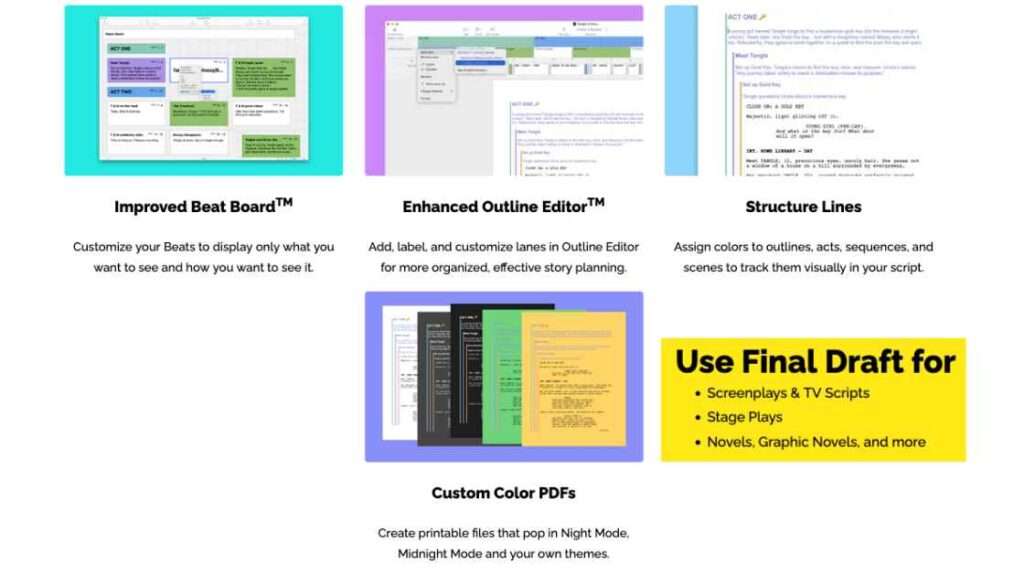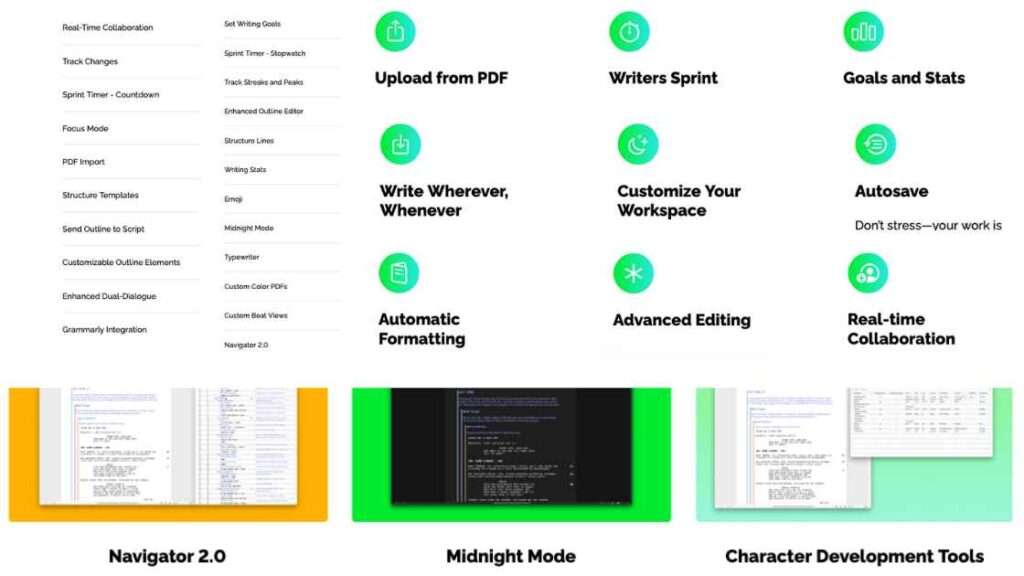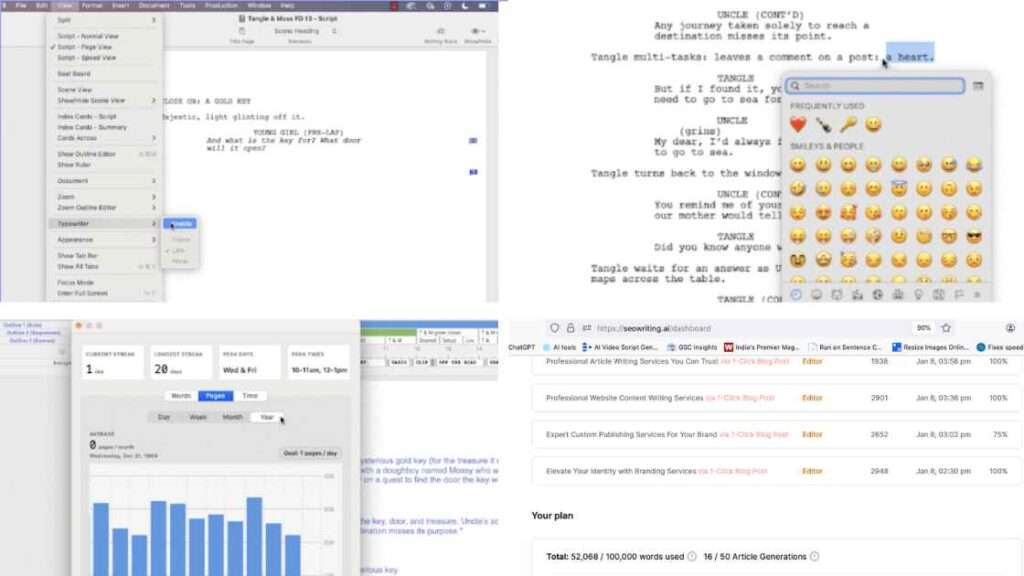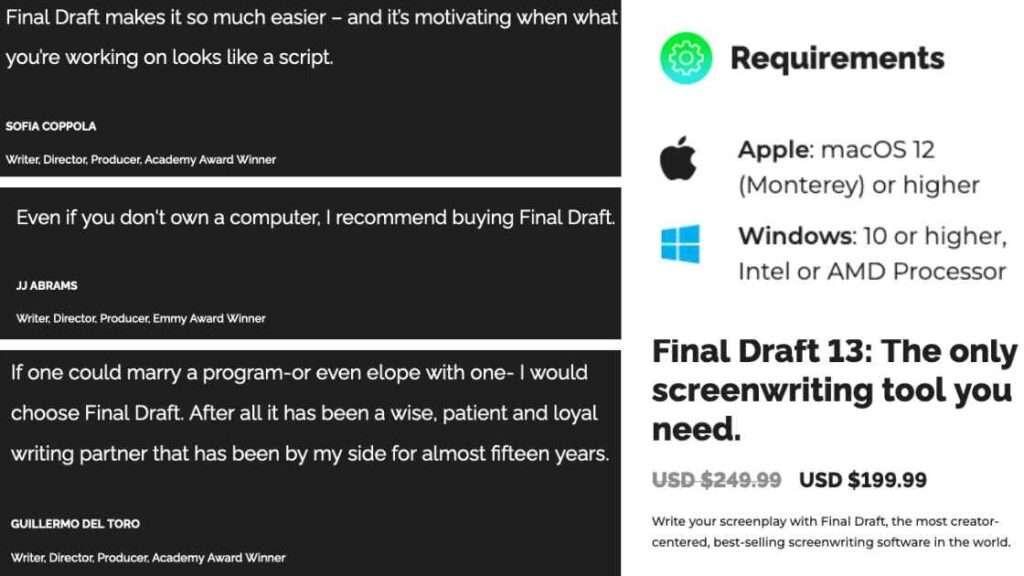Final Draft is a powerful screenwriting software that helps writers format their scripts according to industry standards. It offers a wide range of features and tools to streamline the writing process and ensure consistency throughout the screenplay. With Final Draft writing service, you can focus on crafting a great story without worrying about the technical aspects of formatting. Whether you’re a beginner or an experienced screenwriter, Final Draft is the go-to writing service for producing professional scripts.
Key Takeaways:
- Final Draft is a screenwriting software that helps writers format their scripts according to industry standards.
- It offers a wide range of features and tools to streamline the writing process and ensure consistency.
- Final Draft is the go-to writing service for both beginners and experienced screenwriters.
- With Final Draft, you can focus on crafting a great story without worrying about formatting.
- Professional scripts can be easily produced using Final Draft.

The Importance of Writing with Final Draft
When it comes to writing screenplays for professional film productions, there is no better tool than Final Draft. While regular word-processing programs or free online templates may seem like viable options, they often lack the necessary features and formatting capabilities required by the industry. Without the right screenplay format, your script may require additional time and effort to convert or modify before it is production-ready.
Final Draft saves you from these headaches by providing a comprehensive set of tools specifically designed for screenwriting. With Final Draft, you can ensure that your screenplay is formatted according to industry standards, making it easier for producers, directors, and actors to interpret and execute your vision.
Screenplays written in Final Draft are not limited to just films. Whether you’re writing a stage play, sitcom, novel, or any other form of visual storytelling, Final Draft has got you covered. Its versatility allows you to explore different mediums while maintaining a consistent and professional approach to your writing.
“Final Draft is an industry standard in Hollywood and is trusted by professionals worldwide.”
Final Draft has become synonymous with professional screenwriting because of its powerful features and its commitment to providing a seamless writing experience. The software takes care of the technical formatting aspects, allowing you to focus on what truly matters: crafting a compelling story. By using the screenplay format provided by Final Draft, you can ensure that your script meets the expectations of the industry and stands out among the competition.
Screenplay Format Comparison
Let us compare the requirements of screenplay format for professional film productions:
| Aspect | Regular Word Processing Programs | Final Draft |
|---|---|---|
| Scene Headings | Requires manual adjustment | Automatically formatted |
| Character Names and Dialogues | Not specifically designed for screenplay formatting | Automatically indents and formats character names and dialogues |
| Action and Description | No dedicated structure for action and description | Automatically applies proper screenplay formatting |
| Page Breaks | Manual adjustment required | Automatically inserts proper page breaks |
As you can see, Final Draft takes the guesswork out of screenplay formatting. It ensures that your script follows the industry standard format effortlessly, eliminating the need for manual adjustments and saving you valuable time that can be spent on honing your storytelling skills.
Investing in Final Draft is not only an investment in the software itself but also an investment in your career as a screenwriter. By adhering to the industry standards and producing professional scripts, you increase your chances of attracting the attention of producers, directors, and other industry professionals. Final Draft helps you take that crucial step towards achieving your screenwriting aspirations.

Getting Started with Final Draft
Before diving into writing with Final Draft, it’s important to understand the basic formatting rules of a screenplay. These rules include the layout of the title page, the correct page margins, the standard font (Courier), and the structure of scene headings.
Final Draft simplifies the formatting process by automatically adjusting margins, font sizes, and indents, allowing you to focus on your storytelling. It provides pre-designed templates for different types of scripts, making it easier to start your project with the right structure. These templates include options for feature films, TV shows, stage plays, and more.
To ensure that your screenplay stands out, Final Draft offers customization options for scene headings, character names, and transitions. This allows you to bring your unique creative vision to life while adhering to industry standards.
Here’s an overview of the key formatting rules in Final Draft:
- Title Page: The title page typically includes the title of your screenplay, your name, and contact information. Final Draft provides a standard template for the title page, making it easy to create a professional-looking document.
- Page Margins: Standard screenplay page margins are typically 1.5 inches on the left and right sides, 1 inch at the top and bottom. Final Draft automatically adjusts these margins for you, so you don’t have to worry about manual formatting.
- Font: The standard font for screenplays is Courier, with a font size of 12 points. Final Draft uses Courier as the default font, ensuring that your script maintains the correct appearance.
- Scene Headings: Scene headings are used to indicate the location and time of each scene. They are typically capitalized and written in bold. Final Draft automatically formats scene headings according to industry standards, saving you time and effort.
By following these screenplay formatting rules, you can ensure that your script looks professional and is easily readable by industry professionals.
| Formatting Rule | Description |
|---|---|
| Title Page | Includes the title, writer’s name, and contact information |
| Page Margins | 1.5 inches on the left and right, 1 inch at the top and bottom |
| Font | Courier font, size 12 points |
| Scene Headings | Capitalized and written in bold |
Now that you’re familiar with the basic formatting rules, you can start writing your screenplay in Final Draft with confidence. Let’s explore the next section to learn about writing action and dialogue in Final Draft.

Action and Dialogue in Final Draft
When it comes to writing action descriptions and dialogue in your screenplay, Final Draft offers a user-friendly interface that makes the process a breeze. The software automatically adjusts the format and indentation of dialogue lines, character cues, and parentheticals, saving you time and ensuring consistency.
One of the standout features of Final Draft is its ability to enhance action descriptions. By capitalizing important props or character movements, you can draw attention to key elements of your story and create a more impactful reading experience for producers and readers alike.
Dialogue Formatting
Formatting dialogue is made simple with Final Draft. The software takes care of the technicalities, such as correct indentation and formatting of character names, making it easy for you to focus on crafting engaging and authentic dialogue. Whether it’s a quick back-and-forth or a longer conversation, Final Draft ensures that your dialogue flows seamlessly and is presented professionally.
Parentheticals for Clear Direction
Parentheticals are essential for providing clear direction to actors and conveying the tone of a line. Final Draft streamlines the process of adding parentheticals by automatically aligning them correctly and adjusting the spacing. This allows you to focus on the content and emotional nuances of the line, knowing that Final Draft will handle the formatting for you.
Transitions for Stylistic Elements
Incorporating transitions can add cinematic flair and stylistic elements to your screenplay. Final Draft offers a range of transition options, from traditional cuts and dissolves to more unique transitions like smash cuts and iris-ins. By utilizing these options, you can enhance the visual storytelling of your script and bring your creative vision to life on the page.
Page Breaks and Dialogue Continuity
Final Draft takes care of page breaks and ensures that dialogue continuity remains intact. The software handles the transition from one page to another seamlessly, maintaining the flow of your screenplay and facilitating an immersive reading experience. With Final Draft, you can trust that your script will be formatted correctly, making it easier for casting directors and production teams to navigate.
Final Draft Features for Action and Dialogue
| Features | Action Descriptions | Dialogue Formatting | Parentheticals | Transitions |
|---|---|---|---|---|
| Automatic format and indentation | ✅ | ✅ | ✅ | ✅ |
| Capitalization of props and character movements | ✅ | ❌ | ❌ | ❌ |
| Alignment and spacing of parentheticals | ❌ | ❌ | ✅ | ❌ |
| Wide range of transition options | ❌ | ❌ | ❌ | ✅ |
Final Draft’s intuitive features for action and dialogue formatting make the writing process smoother and more efficient. With its automatic adjustments, you can focus on the creative aspects of your script, knowing that Final Draft will handle the technicalities. So whether you’re describing an intense action sequence or crafting realistic and engaging dialogue, Final Draft is the industry-standard tool that will elevate your screenplay to professional standards.

Learning the Craft with Final Draft
One of the best ways to enhance your screenwriting skills is by immersing yourself in the work of successful screenwriters. Final Draft provides you with a wealth of resources, including an extensive library of scripts, to help you learn from the best in the industry.
By reading actual scripts, you can gain valuable insights into effective screenplay formatting, storytelling techniques, and character development. Final Draft’s online script library offers a diverse collection of scripts from various genres and eras, giving you a comprehensive understanding of different styles and approaches.
Additionally, Final Draft offers a range of screenplay templates that serve as valuable references and guides for your own writing. These templates cover a wide range of script types, including feature films, TV shows, plays, and graphic novels. By studying these templates, you can familiarize yourself with specific formatting conventions and structural elements unique to each type of script.
Experimenting with Writing Styles
Final Draft empowers you to experiment with different writing styles and techniques, allowing you to unleash your creativity and develop a unique voice as a screenwriter. While it’s important to understand and follow industry standards, Final Draft provides the flexibility to customize your scripts and showcase your artistic vision.
Through the software’s intuitive interface and comprehensive toolset, you can easily experiment with formatting choices, scene descriptions, dialogue delivery, and more. By exploring various writing styles, you can find what resonates with you and helps bring your stories to life.
“Every writer has a style, and yours will influence how your story unfolds on the page. Final Draft gives you the freedom to experiment and find your unique voice.”
| Benefits of Learning with Final Draft | Explanation |
|---|---|
| Access to a vast library of scripts | Explore diverse writing styles and learn from successful screenwriters. |
| Variety of screenplay templates | Get familiar with different script types and their unique formatting conventions. |
| Flexibility to experiment with writing styles | Unleash your creativity and develop your own unique voice as a screenwriter. |
As you grow as a screenwriter, it’s important to continuously learn and evolve. Final Draft provides the tools and resources you need to develop your craft, ensuring that you can confidently create scripts that captivate audiences and stand out in the competitive film industry.
The Power of SmartType in Final Draft
Final Draft’s SmartType feature is a valuable tool that can greatly enhance your screenwriting experience. By leveraging SmartType, you have the power to ensure script consistency and generate accurate reports that provide valuable insights into your script’s structure.
SmartType offers a range of categories that streamline the writing process, allowing you to automatically adjust the order of elements such as characters, scene intros, and locations. This ensures a consistent and professional script format, saving you time and effort in manually formatting each element.
Script Consistency Made Easy
With SmartType, you can easily maintain consistency throughout your screenplay. By simply selecting the desired category, such as characters or locations, SmartType will automatically populate the appropriate elements in the correct format. This eliminates the risk of inconsistencies and ensures a polished final product.

Accurate Reports for Deeper Insights
SmartType’s ability to adjust the order of elements is not only convenient but also valuable when generating accurate and reliable reports. By ensuring script consistency, the reports generated from Final Draft will provide you with detailed insights into your script’s structure, allowing you to analyze and refine your work with precision.
Make Informed Decisions with SmartType
SmartType guides you in making informed decisions about your work. By using this powerful feature, you have the ability to experiment with different scenarios and make adjustments effortlessly. The automated adjustments made by SmartType allow you to focus on your creative flow and make the necessary changes with confidence.
The Benefits of SmartType in Final Draft
| Benefit | Description |
|---|---|
| Consistent Script Formatting | SmartType ensures that your script maintains a consistent format throughout, eliminating the need for manual adjustments. |
| Time and Effort Savings | By automating the adjustment of elements, SmartType saves you time and effort, allowing you to focus on your storytelling. |
| Accurate Reports | With script consistency ensured by SmartType, the generated reports offer valuable insights into your script’s structure. |
| Informed Decision Making | By using SmartType, you can experiment with different scenarios and make informed decisions about your screenplay. |

Choosing the Right Screenwriting Software
Selecting the right screenwriting software is a personal choice that depends on your individual preferences and project requirements. It’s essential to conduct a comparative analysis of the strengths and weaknesses of different software options to make an informed decision.
Two popular alternatives to Final Draft are Fade In and Slugline. These apps offer unique features tailored to specific writing styles and needs.
Fade In:
Fade In is known for its user-friendly interface and seamless collaboration capabilities. It supports multiple file formats and offers advanced organizing and outlining features. With its flexible pricing options, Fade In provides an affordable solution for aspiring writers.
Slugline:
Slugline sets itself apart with its minimalist design and focus on simplicity. It prioritizes distraction-free writing and provides tools for quickly navigating your script. Slugline’s powerful auto-fill feature saves time by automatically formatting elements based on context.
As a writer, taking an app-agnostic approach allows for flexibility and the ability to choose the software that best suits each project. While Final Draft is considered the industry standard due to its comprehensive suite of features and widespread adoption, it’s worth exploring alternative options that provide a better writing experience for your specific needs.
When considering various screenwriting software, evaluate factors such as:
- User interface and ease of use
- Available features and customization options
- Collaboration capabilities
- Compatibility with different operating systems
- Price and affordability
Taking the time to thoroughly compare different options ensures you choose the software that aligns with your writing style and project requirements, enhancing your overall screenwriting experience.
Comparative Analysis of Screenwriting Software
| Software | Strengths | Weaknesses |
|---|---|---|
| Final Draft |
|
|
| Fade In |
|
|
| Slugline |
|
|
In conclusion, while Final Draft remains the go-to choice for many professional screenwriters, it’s important to consider other options before making your decision. By conducting a comparative analysis and evaluating the strengths and weaknesses of different software, you can select the screenwriting software that best fits your needs and enhances your writing process.

Conclusion
Final Draft is an indispensable tool for screenwriters, providing a comprehensive suite of features and tools that simplify the writing process and ensure professional script formatting. Widely used in the film industry, Final Draft is considered the industry standard for screenwriting software.
However, it is essential for writers to explore different screenwriting software options to find the one that aligns with their writing style and project needs. While Final Draft offers a powerful set of features, other alternatives like Fade In and Slugline may provide unique capabilities that cater to specific writing styles and preferences.
By utilizing the right writing service, screenwriters can elevate their scripts to their full potential and increase their chances of success in the competitive film industry. Whether you choose Final Draft or another screenwriting software, the key is to find a tool that enables you to bring your creative vision to life and produce professional scripts that captivate audiences.
FAQ
What is Final Draft Writing Service?
Final Draft Writing Service is a powerful screenwriting software that helps writers format their scripts according to industry standards and offers a wide range of features and tools to streamline the writing process.
Why is Final Draft important for screenplay writing?
Final Draft is essential for anyone looking to write a screenplay for professional film productions. It ensures that the script is formatted correctly and production-ready, saving writers the hassle of additional formatting or conversion processes.
Can Final Draft be used for purposes other than screenplays?
Yes, Final Draft can also be used for writing stage plays, sitcoms, novels, and more. It is the industry standard in Hollywood and is widely used by professionals worldwide.
How does Final Draft simplify the formatting process?
Final Draft automatically adjusts margins, font sizes, and indents, making it easier for writers to adhere to the standard screenplay format. It also provides templates and customization options to enhance the overall visual appeal of the screenplay.
What features does Final Draft offer for writing action and dialogue?
Final Draft provides a user-friendly interface for writing action descriptions and dialogue. It automatically adjusts the format and indentation of dialogue lines, character cues, and parentheticals. It also offers a range of transitions to add stylistic elements to your screenplay.
How can Final Draft help in learning screenwriting?
Final Draft provides access to a vast library of scripts online, allowing writers to study the formatting and techniques used by successful screenwriters. It also offers templates for various script types, providing guidance and inspiration for writers.
What is SmartType and how does it enhance the screenwriting experience?
SmartType is a feature within Final Draft that automatically adjusts the order of elements, ensuring consistency throughout the screenplay. It helps generate accurate reports and provides valuable insights into the script’s structure, making it easier for writers to make informed decisions.
Is Final Draft the only option for screenwriting software?
While Final Draft is considered the industry standard, there are other options available such as Fade In and Slugline that offer unique features catering to specific writing styles and needs. It’s important to explore different software options to find the one that best suits your preferences and project requirements.
Why should writers choose the right screenwriting software?
Selecting the right screenwriting software is crucial as it can greatly impact the writing experience and the quality of the final script. By choosing the right software, writers can optimize their screenwriting process and elevate their scripts to their full potential.
